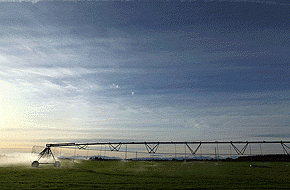
[This is the first part in a series of four. Part one focuses on dairy, part two on sheep, beef and dairy support, and part three on horticulture, arable and processed crops.]
The potential ability to export embodied water and better manage the volatility of Mother Nature means huge attention needs to be paid to deriving cash value from water storage and new irrigation projects.
Our research shows average per hectare returns for the various land uses under irrigation of: $2,380/ ha for dairying; $2,000/ha for arable and processed crops; $700-$900/ha for sheep, beef and dairy support; and a wide range for horticulture depending on crop, variety and location.
However, around these averages there are wide ranges depending on a number of factors.
Top farm management performance, moderate-to-average existing debt levels, and reasonable prices are often required to make a switch to irrigation work for an existing land owner.
A change to irrigation and new farm policy also requires developing a business plan, project plan, and budget, as well as completing the changeover on time, to specification and within budget.
Vulnerability is at its highest in the first few years of a changeover, so successful execution is a critical component of success.
For a farmer/grower considering irrigation and a change of land use or farm policy there are many factors that need to be weighed up.
There is no “one size fits all” solution, and anyone considering investing in irrigation should get good advice to work out the viable options for their particular situation.
Get the execution right though, and what our analysis has shown is that – in most cases – investment in irrigation can be made to work in today’s business environment despite the many challenges and the higher cost of accessing water.
Introduction
New Zealand is a nation rich in renewable resources. In fact we rank number 1 for renewable resources (on a per capita basis) according to the World Bank’s Wealth of Nations report.
We have plenty of land and water whereas a host of other counties are a bit short.
How New Zealand unlocks these resource endowments is strategically important for the country’s long-term success. In many ways our renewable resources are New Zealand’s winning lottery ticket if GDP per capita aspirations are to be achieved.
A key component is irrigation.
As we highlighted back in June, over the last five years there has been a 17 percent increase in the land area in New Zealand under irrigation to 721,700 hectares, as well as a shift to more efficient irrigation systems.
Additionally there are currently plans in place for 16 new water storage and irrigation schemes around the country.
If completed, these have the potential to nearly double the total irrigable land to 1.38 million hectares, or 12 percent of New Zealand’s total agricultural land.
Building the 16 proposed schemes is not expected to be cheap, with a total projected cost of between $4 and $5 billion, or $6,100 to $7,600 per hectare
Coming up with this sizeable amount of capital requires innovative financing solutions. The key issue for funding the development of irrigation schemes is not so much the availability of funding per se, so much as it is the certainty of cash flow.
In most cases this is largely determined by farmer uptake of irrigation.
A high uptake from day one by farmers creates more cash flow certainty and therefore more certainty for investors.
There are many factors that will influence a farmer’s decision to invest in irrigation or not. In most cases financial returns and the starting point for equity within a farm will probably be the two most important factors.
Obviously returns are influenced by a myriad of factors, but a change of land use, or at least farm policy, will be required when converting to irrigation.
The physical and environmental aspects of a piece of land will determine the potential opportunities for land use change to a different enterprise.
These include factors such as soil type, topography, rainfall, climate, and aspect. An individual’s appetite to adopt a particular farm policy, or change to an alternative enterprise, will be influenced by their attitude to risk, existing debt levels, availability and sources of capital, age, experience in different fields, and family circumstances.
When capital is a limiting factor, the farm system may move toward the highest return on total assets rather than the highest return on new capital employed.
For example, a farmer with high existing debt levels may move to intensive finishing and dairy support rather than dairy conversion, as the step-up in capital requirements with the latter would be large.
Influences outside the farm-gate also need to be considered. These include things such as environmental regulation, farm-gate prices and other budget parameter expectations, surrounding industry infrastructure, and the fine print (cost, reliability and terms and conditions) of the irrigation scheme, or water take.
Our analysis explicitly avoids looking into the impacts of environmental constraints on the economics and feasibility of investing in irrigation and a change of land use.
At the moment a number of unknowns in this area is one of the greatest uncertainties holding farmers back from investing in irrigation.
Environmental constraints are highly relevant for the risks around the productive capacity and cost assessments of the different land uses under irrigation.
However, it is an area that applies equally to both existing dry land and irrigated farms. Therefore to avoid this extra complexity – and because it is not solely an irrigated area issue – we have not spent time on it. Previous Agri Focus editions have touched on the topic of nutrient limits and other regulatory change occurring in the water space; interested readers should refer to this for more detail.
When all the mentioned factors are put into the mix it is often difficult for a farmer to decide on what their realistic options are under irrigation, and which option best suits their circumstances.
The complexity also makes for a difficult job in coming up with a coherent financial assessment of the options and the risks around each.
Therefore, we thought it would be topical to look at the average returns from different land uses under irrigation and the key sensitivities. Our disclaimer for those reading on from here is that anyone considering converting to irrigation, or capital upgrades to existing irrigation infrastructure, should do their own due diligence and use local expertise to make the assessment relevant to their situation, because as mentioned above there are many factors to consider.
The complexity of the issue also makes even generalised analysis no simple task.
Firstly, getting robust and standardised data across a good range of different land uses proved challenging. This was mainly due to the many factors that need to considered, as well as limited data availability. Another limitation was the large range of accounting practices and analytical frameworks used in the financial assessments of the different irrigation schemes.
Nevertheless, despite these limitations, we think the analysis contained in this article adds some value to the debate around the different returns from land uses under irrigation.
We would like to acknowledge all the parties that contributed data, information and time to this research. These included Dairy NZ, Beef + Lamb NZ, Baker and Associates, Roy Evans Ltd, Macfarlane Rural Business Ltd, the Ministry for Primary Industries, and the six proposed schemes analysed.
These six schemes included the Canterbury Central Plains Water, Ruataniwha Water Storage Project, North Otago/Waitaki district development, Hurunui Water Project, Flaxbourne Community irrigation scheme, and Waimea Water Augmentation community dam.
First, we have gathered together all the publicly available information from irrigation schemes where some financial analysis has been completed within the last couple of years. In total we managed to gather together datasets and analysis from 10 different sources (six proposed schemes and four other datasets of existing land under irrigation), but often there have been multiple models, or variations produced to highlight different options. Where possible we have grouped the different options under common land uses and then analysed and standardised key assumptions to produce an Income and Expenditure assessment for different land use options. Where grouping has proved to be too difficult we picked out a couple of stand-alone models related to a particular irrigation scheme to highlight the possibilities.
-------------------------------------------------------------------------------------------------------------------------------------------
Farms For Sale: the most up-to-date and comprehensive listing of working farms in New Zealand, here »
-------------------------------------------------------------------------------------------------------------------------------------------
Dairy
Dairying seems to dominate irrigation conversions these days, making up the majority of land use change that occurs when water becomes available.
Over the page is an Income and Production Statement we’ve produced as a ‘central’ scenario for dairying under irrigation.
Key assumptions are a milk price of $6.10 per kg and dividend of $0.35 per share. This is a little higher than we use for long-term dairy budgets, but the irrigation schemes analysed seemed to be in consensus on this assumption, with the vast majority using this level of pricing to analyse dairying returns.
In our view, banks have historically been a little conservative in their assessment of the long-term milk price for a variety of reasons.
On the production side of things we have used 1,500 kgs MS/ha. This was one area where there was quite a wide range of assumptions used, ranging from 1,288 to 1,637 kgs MS/ha.
In the discussion on production potential the various assessments noted that an even larger range of 1,000 up to 2,000 kgs MS/ha was currently being achieved by dairy farms under irrigation. The result was often linked to management ability and skill in utilising the irrigation and extra pasture grown to maximise production. Soil type was also mentioned as being influential.
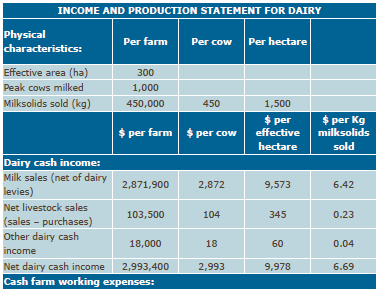
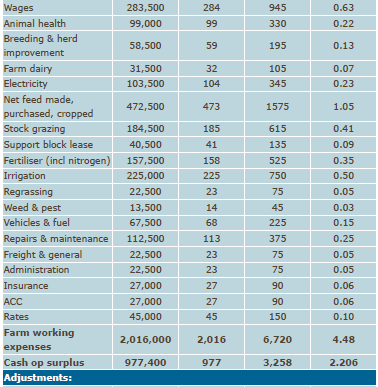
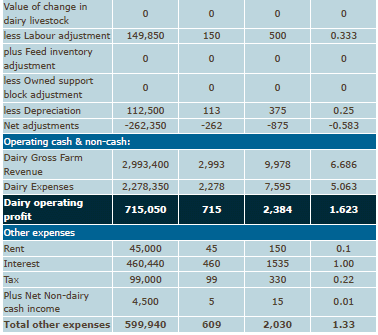
Dairy NZ also kindly provided some data on the physical and financial performance for the 2011-12 season for existing dairy farms under irrigation in the Canterbury region (Dairy NZ irrigated farms were defined as having greater than 30 percent of the milking platform under irrigation). The data showed higher average production levels of around 1,600 to 1,700 kgs MS/ha and a slightly larger range. The low side was similar at 1,000 kgs MS/ha, but 14 percent of the farms surveyed achieved above 2,000 kg MS/ha in 2011-12.
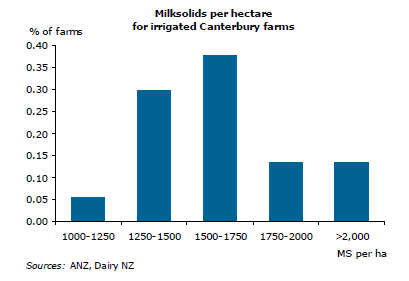
On the cost side we did a bottom-up exercise and came up with farm working expenditure of $4.5 per kg MS, or $6,720/ha (cost of irrigation included). Obviously, irrigation costs vary substantially across the different schemes depending on how they are funded and the amount of water that needs to be used, which will be influenced by the physical and environmental aspects of a property. Some schemes have a high capital cost to sign up and lower annual charge, with farmers’ capital used to help finance the off-farm infrastructure.
In this case, the annual water charge, plus the annual cash cost for the off-farm capital via an interest cost if debt funded (or opportunity cost if equity funded), are the main impacts on cash flow.
Some schemes on the other hand only have a direct charge for the amount of water used and no off-farm capital requirements. For the purposes of this analysis, we have used a direct annual charge of $750/ha, or $0.50 per kg MS.
Nevertheless, we would note the annual cash cost varied from $0.12 to $0.60 per kg MS depending on the split.
The other main areas of analysis sensitivity were:
1. Net feed made, purchased, or cropped, which seemed largely to depend on the pasture and feed assumptions used.
2. Electricity charges, which depended on how the water is delivered (piped, pressure etc) to the farm-gate, and other on-farm specifics, such as the type of irrigation infrastructure employed.
For the other areas of farm working expenditure there was little variation. The result of $6,720/ ha was surprisingly close to the average result from the Dairy NZ survey farms for 2011-12 of $6,770/ha.
The range of farm working expenditure from the Dairy NZ figures was very large though, with 10 percent of farms having costs below $5,000/ ha and 10 percent above $9,000/ha. Even adjusting our assumed irrigation costs by the variation across the schemes only provides for a variation of -$600 to +$150/ha.
Some of the variation could be attributed to the stage of development (higher costs earlier on) and perhaps the proportion of the property that is being irrigated, but the degree of variation also suggests there is some flexibility in cost structures and a wide range of systems being used under irrigation in Canterbury.
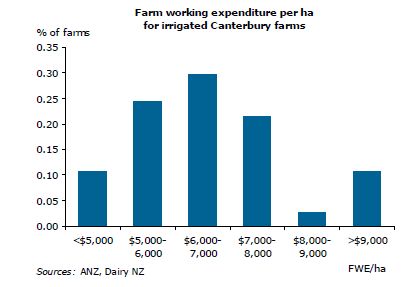
All up, our ‘central’ scenario gives a cash operating surplus of $3,260/ha.
When a labour adjustment (which could be considered drawings for an owner-operator) and depreciation is removed, an underlying profit of $2,380/ha (before interest and tax) is derived.
As we have used a milk payout that is very close to the 2011-12 actual ($0.05 per MS difference for 100 percent shared backed farmer) a comparison can be made with the operating surplus from the Dairy NZ data for irrigated farms in Canterbury.
These results showed an average above our assessment, at $4,095/ha. This was largely due to higher production levels than our assumed 1,500 kgs MS/ha.
The range of results – 8 percent of farmers achieving below $2,000/ha, as well as 8 percent above $6,000/ha –highlights the variation though, due to all the factors mentioned earlier.
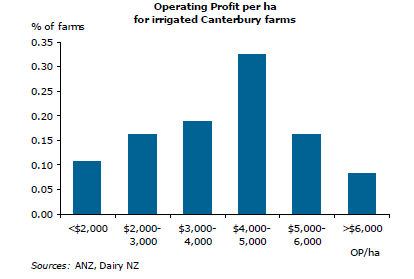
Dairy sensitivity analysis
Sensitivity analysis is always important to understand the range of outcomes possible under different circumstances.
For a dairy farmer it is relatively straightforward, with milk price, production, and expenditure the key areas to understand.
The below table shows the different underlying profit scenarios per hectare for the milk price against production and farm working expenditure. This analysis holds the different expenditure categories per MS the same under each scenario.
In reality some of these aspects would also change depending on the situation. Production and expenditure tend to be directly under the control of farmers, whereas the milk payout is outside a farmer’s direct control.
If there is reasonable confidence around expenditure and production then the sensitivity analysis of operating profit to the milk payout is the largest factor that determines a farmer’s ability to invest or not (i.e. borrow, or source additional capital to convert).
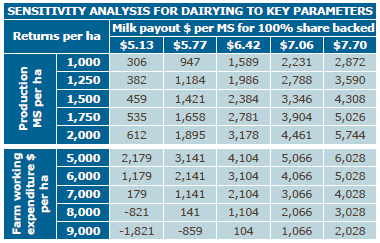
In our budget we have also adjusted the interest cost to a level that provides an interest cover ratio of 1.25 under the central scenario at an assumed fixed tax rate. Generally this is the minimum interest cover ratio level banks are looking for when providing finance.
Under this scenario it indicates an interest cost of $1.00 per MS, or $1,504/ ha, is sustainable.
At a long-term interest rate of say 7 percent, this implies there is potential to borrow nearly $21,540/ha, or $14.40 per MS. This might sound like a lot, but analysing recent conversion costs in Canterbury indicates that farmers looking to convert from dry land arable, or meat and fibre operations to irrigated dairy would need to have plenty of equity to start with.
According to our analysis in the table below, recent conversion costs in Canterbury have averaged $9,400/ha. Add to this buying dairy cows, and if a farmer were to supply Fonterra (as assumed with the dividend included in the milk payout), shares of $10,500/ha would be needed at today’s price of $7 per share (assuming production of 1,500 kgs MS/ha).
This skyrockets the conversion cost to a shade over $26,000 per hectare.
Fonterra’s new capital structure provides more flexibility around shareholdings and the time over which to become fully shared, helping to alleviate the upfront cash requirements. Still, it implies anyone looking to convert from an arable or meat and fibre farm to dairying would need to have at the very least 80 percent equity (if not more) to be able to entirely debt fund the change these days.
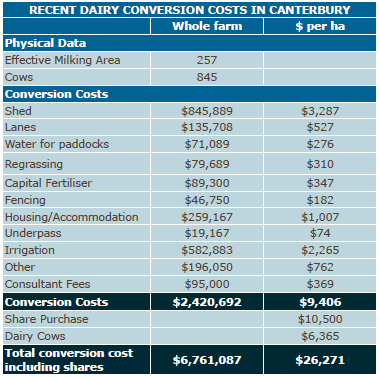
Most of the irrigation schemes had assumed similar conversion costs to these, but one area of variation was on-farm irrigation costs.
Our analysis has pegged these at $2,300 per hectare, where many of the schemes analysed had higher costs of $3,000 to $6,000 per hectare. This probably reflects the type of on-farm irrigation infrastructure employed, shape of block to be irrigated, and proportion of property that is under irrigation.
This suggests conversion costs could be up to $4,000/ha higher than our $26,300/ ha assumption, depending on these specific factors.
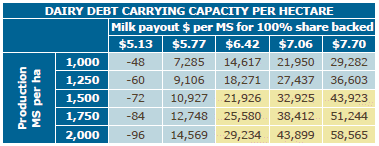
In an attempt to draw out some of the sensitivities, the above table shows debt loadings per hectare with an assumed interest rate of 7 percent and interest cover ratio of 1.25.
What it clearly shows is that given today’s conversion costs, both a reasonable milk payout (milk price and dividend) above $6.50 per MS, and high productivity – at least above 1,500 kgs MS/ ha, are required to make it work when going off one of the banks’ key criteria to assess the ability to repay a loan.
[The next instalment will focus on sheep, beef, and dairy support farms.]
-------------------------------------------------------------------------------------------
This article was first published in the ANZ Rural Focus. It is reprinted here with permission. The full Report is here.
1 Comments
"The potential ability to export embodied water and better manage the volatility of Mother Nature means huge attention needs to be paid to deriving cash value from water storage and new irrigation projects"
Given some recent seismic activity on previously unknown(?) faults, might want to add in some risk factor for earthquake events on water storage.
We welcome your comments below. If you are not already registered, please register to comment.
Remember we welcome robust, respectful and insightful debate. We don't welcome abusive or defamatory comments and will de-register those repeatedly making such comments. Our current comment policy is here.